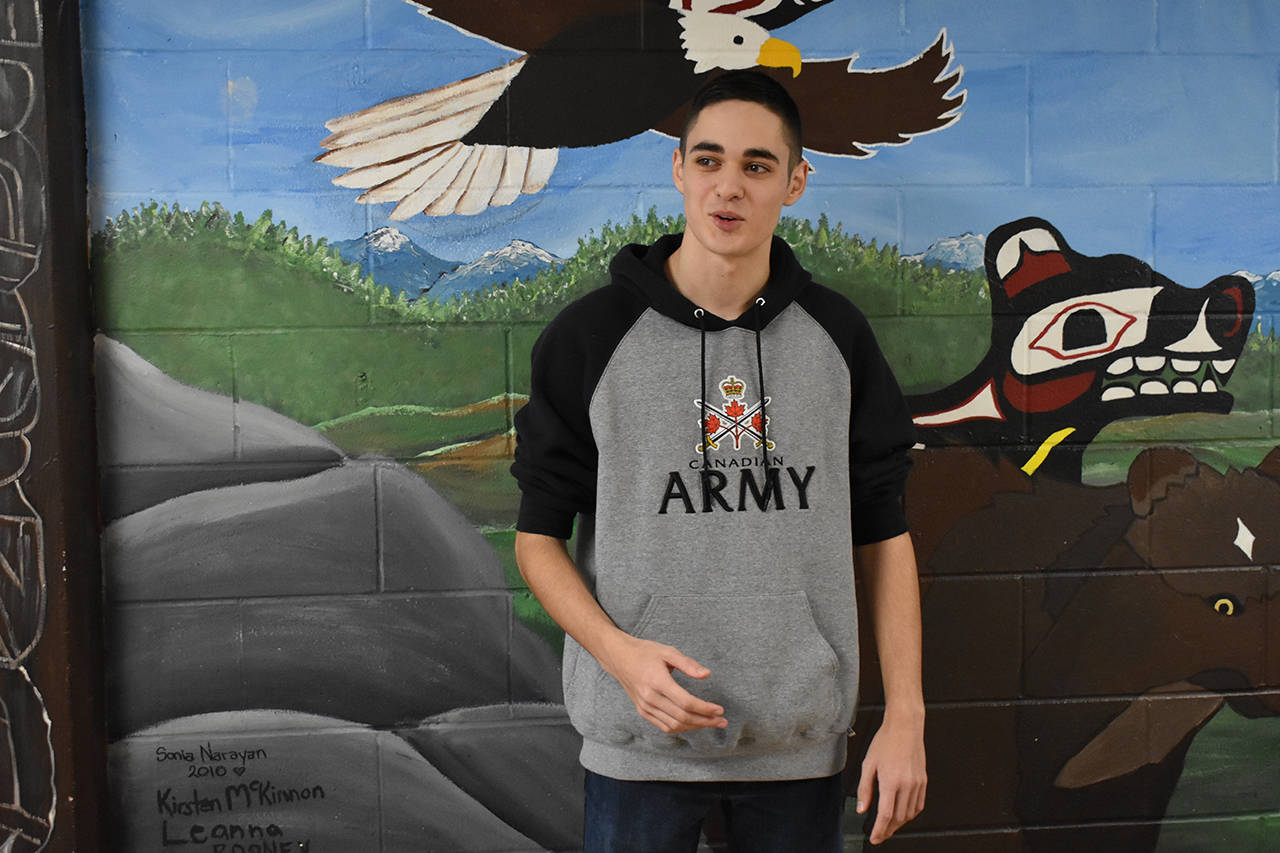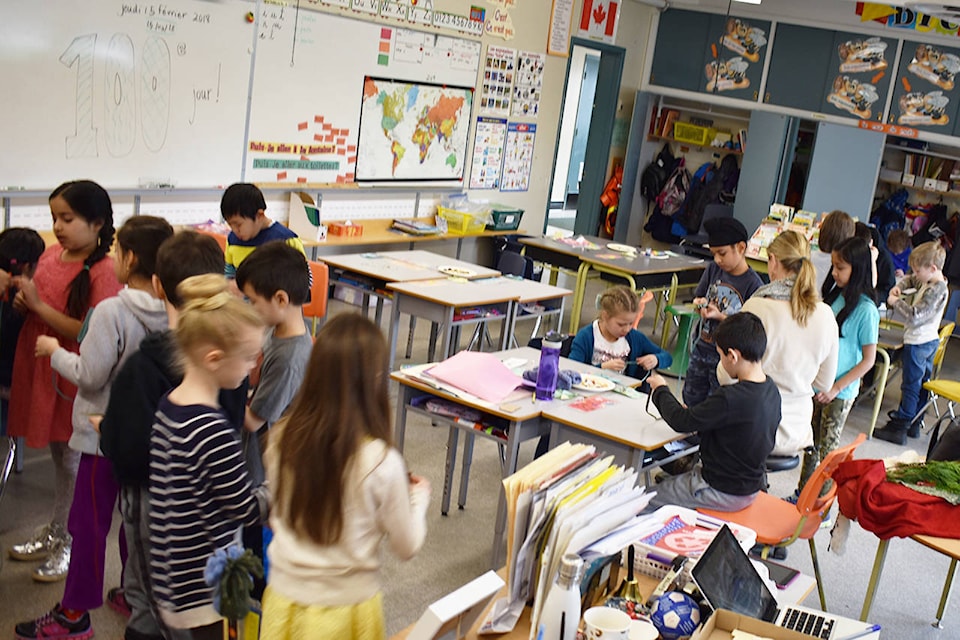Part two in a series looking at what the Delta School District is doing to support its Indigenous students. Read part one here.
When Catherine Watson goes to work, she takes a box of books with her.
Each book ends up on the desk of an Indigenous student in one of six Delta elementary schools. When it’s time for the class to sit down and read, either Watson or a learning support teacher will come in and listen to that student read out loud.
“They’re quite challenging books, but the content is so interesting,” Watson said. The books, produced by Indigenous publisher Strong Nations, feature different stories from local First Nations at a variety of reading levels.
“The nice thing is that all the children in the class like the books, and that’s the goal,” Watson continued. “We want everybody to be participating in what we’re doing.”
So what is Watson doing?
As an early literacy coordinator with the Delta School District, Watson focuses on increasing literacy for students in Grades 1 to 3. Over the last year, her attention has been on Delta’s young Indigenous students, who struggle more than non-Indigenous students in reading and writing.
“My goal is literacy for all, as all of our goals are,” Watson said. “But when we see that there’s a subset of our students who are having difficulties beyond what the other students are having, then that’s why this year, our focus in literacy … is on students with Indigenous ancestry.”
Watson educates learning support teachers and classroom teachers on how to give extra help to those students. Sometimes, she goes into the classroom herself and teaches the alphabet, listens to them read or encourages them in writing.
The techniques she uses aren’t any different than the ones she uses to teach non-Indigenous students — just like the reasons why Indigenous students are struggling with reading and writing aren’t any different than those for non-Indigenous students.
“I didn’t see anything different in the difficulties that they were having than would be true of anybody,” Watson said, whether that’s having difficulties with language comprehension, understanding letters, or understanding the structure of the language. “But I did see higher frequency. So there’s an issue we have to investigate: why is this?
“But for me, right now, it’s just that I know where their problem area is,” she continued. “By doing this kind of thing, we can tailor the focus that we’re giving them to where they’re having difficulty.”
In her position with the school district, Watson is focusing on how she can solve those difficulties. She doesn’t know why Indigenous students are struggling more than non-Indigenous students and, as she is keen to point out, those reasons don’t matter in her work.
“The outside influences, I can’t do anything about that,” Watson said. “I can make a difference, I hope, with your literacy.”
“I guess what I’m saying … is I’m concentrating on what I can do,” she continued. “There are lots and lots of factors over which a school has no control. But I’m not going to be looking at those and saying this is the reason you’re having trouble, because you’ve come to me, and my job is to make you literate.”
Fighting low expectations
Others in the district, however, are putting a greater emphasis on those reasons. And one of the big reasons is what is commonly called the “racism of low expectations,” where teachers and other educators have low expectations of what Indigenous students can do because of biases about their race.
Juanita Coltman, K-12 policy manager for the First Nations Education Steering Committee and a member of the Nuxalk Nation, experienced the repercussions of those low expectations first hand when she was an elementary student in Ontario.
“I was at the activity table in Grade 1,” she explained. She was supposed to identify everything on the table that was green and colour it in a little booklet using a green crayon.
“I couldn’t do it,” she said. “I sat there forever, trying to make sense of this. And it wasn’t until I kind of stepped back and made a holistic understanding that this crayon represents all the different shades of green … could I do the activity.”
But almost immediately, she said, “a lot of those stereotypes start coming into play. And all those discrimination things: this child, she can’t do it. She must be special needs. Why can’t she do it? Something’s wrong with her.”
Right away she started getting tested, Coltman said. “They were trying to know what’s wrong with my eyes, what’s wrong with my ears. Let’s do a psych-ed test, let’s put her on learning assistance.
“And there’s nothing wrong with me,” she continued. “I just learn differently. I understand differently. And that’s why you have that over representation” of Indigenous students with special needs designations.
In Delta, Indigenous students are about three times more likely to have a special needs designation that non-Indigenous students. Nearly half of the Indigenous students with designations had behavioural disability designations, and about a quarter had learning disability designations.
The racism of low expectations also compounds in high school. Provincially, Indigenous students are statistically more likely to take courses that limit their options for university (such as taking Communications 12 instead of English 12) and are less likely to achieve high marks in provincially examinable courses.
“It shows that kids are just getting kind of pushed through the system; they’re doing the minimum. And teachers aren’t holding them accountable,” Coltman explained. “There’s no high expectations for them to do well or achieve better than a C+.”
But, she said, “you really want the system to kind of see that students can do it. All students can do it. All students can learn. And we expect the same high expectations for all students, instead of just pushing our Aboriginal kids through.”
For Chief Bryce Williams, the racism of low expectations is “probably one of the most significant barriers” for young members of the Tsawwassen First Nation. Those students make up about 10 per cent of the Delta School District’s Indigenous population.
The Tsawwassen First Nation has an after-school homework program for its students, and has recently hired a new teacher to work there. But more help needs to come from the atmosphere at school.
“I guess in the absence of expectations for students to achieve, an environment has to be created where low achievement is considered [unacceptable],” Williams said.
That is something the district has been focusing on, both at a policy level with projects like the equity scan and at the school level.
Changing avenues of success
In 2016, the Delta School District underwent an Aboriginal education review that looked at the challenges Indigenous students face, and how the district can better support their future success.
In that review, several key issues came to light: among them the pull-out program, which took Indigenous students out of class to learn about First Nations culture, and the need for additional academic supports.
Jessica Le Brun, an Indigenous success advocate at Delview Secondary, is one of the people providing additional support for Indigenous students at the high school level. She came into her role for the 2017-2018 school year, after previous years as a social studies and learning support teacher.
The program now “just looks a little different,” Le Brun said, “and as a teacher, it’s allowed me to do a little bit more than perhaps previously.”
“As in any student population, the needs are so different with students,” she explained. “My role, for a lot of our students, is kind of overseeing.”
For Le Brun, that can mean providing individualized support during flex time, connecting with them about homework, checking in on graduation requirements, or reaching out to counsellors and other support staff.
The changes that shaped her role are part of what Le Brun called a district-wide “mindset of inclusion.”
The mindset of inclusion is the idea that success for Indigenous students is best achieved by educating all students about First Nations culture. It stems from the federally-recognized need for reconciliation between Indigenous and non-Indigenous Canadians, and in schools it can be tangibly seen in First Nations content included in the new B.C. curriculum, as well as the removal of the pull-out program in the last two years.
Delta School District Elder Roberta Price has always been against the pull-out program.
“I would not allow my kids to be pulled out because I wanted them to graduate,” she said. “They were missing Socials. They were missing Math. They were missing English. I wanted them to graduate, so I didn’t support that.”
Now, Price goes into schools to teach First Nations culture to whole classes. Le Brun, in her role, has people like Price or Delta’s Indigenous cultural enhancement facilitators come in during flex time to teach First Nations traditions.
“Some students … miss the old pull-out,” Le Brun said. “Others quite like [the new program] because they aren’t missing their academic classes.”
Grade 11 student Lachlan McPherson is one who misses the program. Too old to take advantage of the updated B.C. curriculum with its infused First Nations content, McPherson said he feels he hasn’t been able to learn as much about his Cree heritage since the pull-out program ended.
“The pull-out program would take you out of certain classes — only if, let’s say, you had a test, you couldn’t go out. You had to prioritize,” he said. “But the reason for it was to learn about our background.
“And we still — some would — get that,” he explained. “But with the pull-out program, I just feel like we learned a lot more.”
For McPherson, who only found out he had Cherokee ancestry at the end of elementary school, discovering his heritage through school was an important part of his learning.
“This new part of me that I didn’t really know that I had, I wanted to learn more about it for sure,” he said.
“I wish I knew more though … I don’t know that much,” he continued. “And not all of it is because of the program. I need to put my own foot forward on that a bit too.”
Next week, we’ll look at the ways the Delta School District and the province are supporting Indigenous students culturally, and why many administrators feel that is key to their success.
Correction: The print version of this article incorrectly spelled Lachlan McPherson’s last name and identified his ancestry as Cree, not Cherokee. Both those errors have been fixed in the online version.
grace.kennedy@northdeltareporter.com
Like us on Facebook and follow us on Twitter

